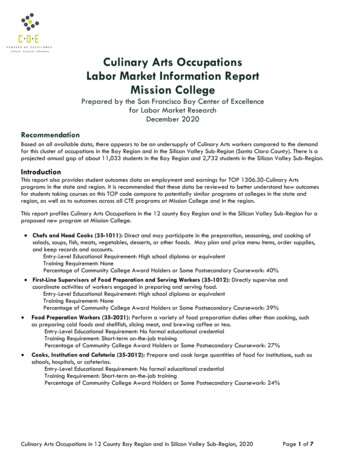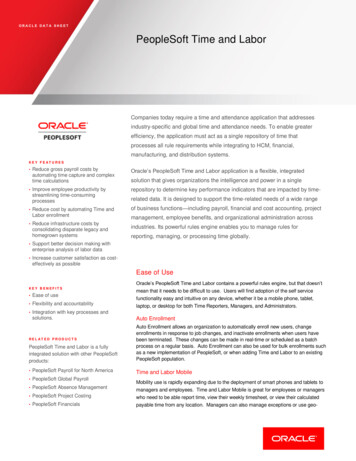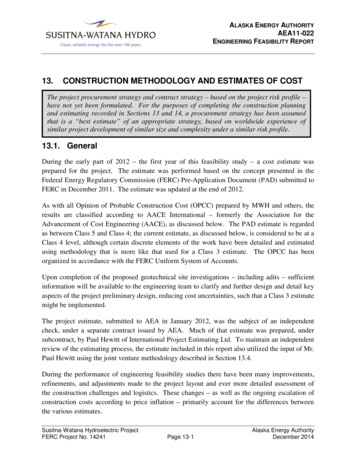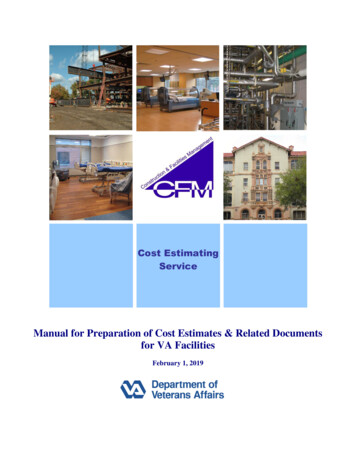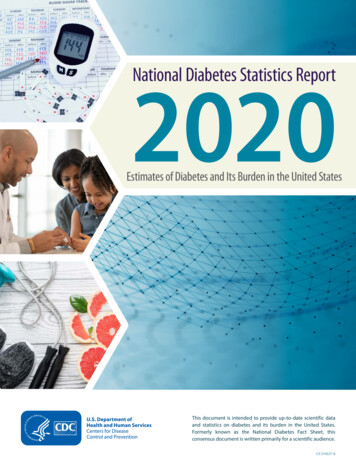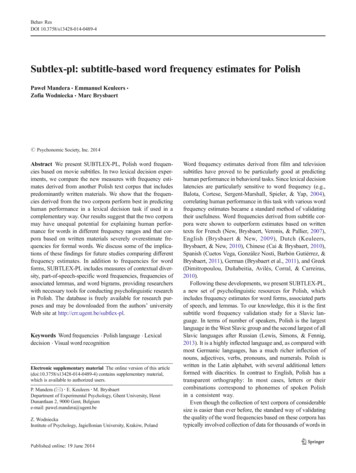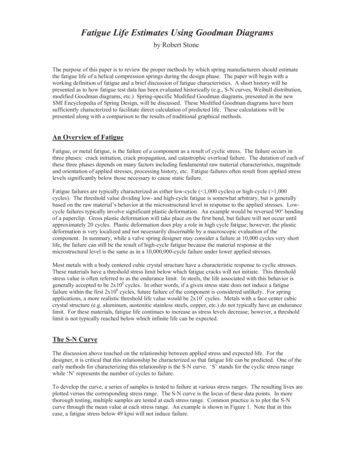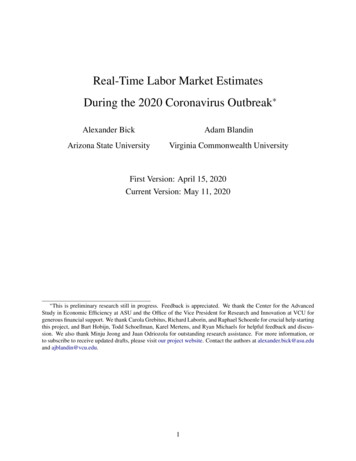
Transcription
Real-Time Labor Market EstimatesDuring the 2020 Coronavirus Outbreak Alexander BickAdam BlandinArizona State UniversityVirginia Commonwealth UniversityhiFirst Version: April 15, 2020Current Version: May 11, 2020 This is preliminary research still in progress. Feedback is appreciated. We thank the Center for the AdvancedStudy in Economic Efficiency at ASU and the Office of the Vice President for Research and Innovation at VCU forgenerous financial support. We thank Carola Grebitus, Richard Laborin, and Raphael Schoenle for crucial help startingthis project, and Bart Hobijn, Todd Schoellman, Karel Mertens, and Ryan Michaels for helpful feedback and discussion. We also thank Minju Jeong and Juan Odriozola for outstanding research assistance. For more information, orto subscribe to receive updated drafts, please visit our project website. Contact the authors at alexander.bick@asu.eduand ajblandin@vcu.edu.1
AbstractLabor market statistics for the United States are collected once a month and published with athree week delay. In normal times, this procedure results in timely and useful statistics. Butthese are not normal times. Currently, the most recent statistics refer to April 12-18; new statistics will not be available until June 5. In the meantime, the Coronavirus outbreak is rapidlyreshaping the US economy.This project aims to provide data on labor market conditions every other week, and to publishresults the same week, thereby reducing the information lag. We do so via an online labor market survey of a sample representative of the US working age population, which we refer to asthe Real-Time Population Survey (RPS). The core labor market questions in the RPS closelyfollow the government survey (the CPS), which allows us to construct estimates consistentwith theirs. We also ask a suite of additional questions which are not asked by the CPS. Thefirst three surveys cover the weeks of March 29-April 4, April 12-18, and April 26-May 2.We first compare labor market outcomes in the RPS and the CPS up through April 12-18:1. Retrospective questions about employment, hours worked, and earnings in February generate distributions strikingly similar to the February CPS.2. Relative to the change in the CPS from February to April, the RPS exhibits larger changesin employment, unemployment, and labor force participation.3. Taking into account misclassification issues raised by the BLS substantially narrows thedifference between the CPS and RPS estimates for employment and unemployment. Thisis because missclassification appears to be more prevalent in the CPS than in the RPS.Our most recent estimates suggest that declines in employment have slowed since mid April:4. In the week of April 26-May 2, we estimate that the employment rate was 51.4% amongworking age adults. While employment fell in our most recent wave, the decline hasslowed noticeably.5. We estimate the unemployment rate rose since mid April to 23.6% while the labor forceparticipation rate remained fairly flat (though well below its level in March).6. Most of those who have recently lost their job believe they could return to their old jobif the economy were to reopen soon and in a safe manner.7. Among those who were employed in February, 44% have experienced a loss in earnings.
1IntroductionThe 2019-2020 Coronavirus outbreak has prompted a sharp economic downturn in the US andaround the world. Designing and implementing an effective policy response to the crisis is now amajor priority for policymakers and researchers.Effective policies require timely and accurate data on the scale of the downturn, yet traditionaldata sources are only made available at a significant lag. For example, the April Employment Situation Report by the Bureau of Labor Statistics (BLS) was released Friday May 8. However, thisreport reflects labor market conditions from the week of April 12-18, and so is already three weeksout of date. The next BLS report will not be released until June 5. The gap between the data needsof policymakers and the time lag of traditional data sources has left policymakers “flying blind” toa significant degree.The goal of this project is to help fill that void. To do so we collect online survey data everyother week from a sample representative of US adults (ages 18 and over). The survey questionsclosely follow the structure of the Basic Labor Market module in the Current Population Survey(CPS), which allows us to compute labor market estimates consistent with their measures. We alsoinclude a suite of questions specifically tailored to the present economic situation which are notasked by the CPS. We refer to our survey as the Real-Time Population Survey (RPS).The first wave of the RPS references the week of March 29–April 4; the second wave references the week of April 12–18; the third wave references the week of April 26–May 2.We first compare labor market outcomes in the RPS and the CPS up through April 12-18:1. Retrospective questions about employment, hours worked, and earnings in February generatedistributions strikingly similar to the February CPS (see Tables 1 and 2).2. Relative to the change in the CPS from February to April, the RPS exhibits larger changesin employment ( 18.9 percentage points (pp) in the RPS vs. 11.1 pp in the CPS), unemployment ( 13.8 pp vs. 10.4 pp), and labor force participation ( 10.2 pp vs. 3.8 pp).3. However, the BLS identified over 7 million individuals who were classified as employedand absent, but should have been classified as not employed. Adjusting the CPS figures byrelabeling most of these as unemployed (as suggested by the BLS) substantially narrowsthe difference between the RPS and CPS estimates for the change in employment ( 18.9pp in the RPS vs. 14.8 pp in the CPS) and unemployment ( 13.8 pp vs. 15.3 pp). Byconstruction this exercise does not affect labor force participation since it involves movingindividuals from employed to unemployed. We emphasize that the BLS’s suggestion torelabel all the misclassified as unemployed could overstate the labor force participation rate,since misclassified individuals are not asked questions necessary to assign them in/out of thelabor force.4. An alternative exercise is to compare the “employed and at work” rate, which treats absentworkers as if they were not working, and therefore should avoid the misclassification issue1
discussed in the previous item. For this measure the RPS and CPS estimates are closer aswell: the share employed and at work fell 19.0 pp in the RPS vs. 14.8 pp in the CPS. This isbecause the misclassification issue described above appears to be more prevalent in the CPSthan in the RPS.Our most recent estimates suggest slowing declines in employment since mid April:5. In the week of April 26-May 2, we estimate that the employment rate was 51.4% amongworking age adults. While employment fell since mid April, the decline slowed noticeably.6. We estimate the unemployment rate rose since mid April to 23.6% while the labor forceparticipation rate remained fairly flat (though well below its level in March).7. Most (55%) of those who have recently lost their job believe they could return to their oldjob if the economy were to reopen soon and in a safe manner, while 16% were unsure and29% believed that their job loss was permanent.8. Among those who were working in February, 44.1% report lower earnings. This includes29.0% who were not employed, and 15.6% who are still employed but earning less. Atthe same time, 11% of those working in February report higher weekly earnings last weekcompared with February.9. We estimate that hours worked per working age adult fell 32% since February. Initially thereduction in hours was roughly equally due to reductions in employment and reductions inhours per employed. Recently, however, reductions in employment have continued, whilehours per employed have increased slightly. This may be due to a composition effect, to theextent that workers whose hours initially declined in late March and early April might havebeen more likely to transition to non-employment.10. Declines in employment were initially concentrated among women, but this difference hasrecently diminished. Reductions in employment are somewhat more pronounced amongolder and less educated workers. Overall, however, the most striking pattern in our estimatesis that the reduction in employment is pervasive across broad demographic groups.In the next section we provide a brief overview of our online survey and compare it to someother labor market surveys. Section 3 summarizes the results of validation exercises comparinglabor market outcomes in our survey to outcomes in the February and April CPS. Section 4 documents the key estimates for labor market aggregates derived from our survey. Section 5 documentshow earnings have changed among individuals who were employed in February. Section 6 documents heterogeneity in labor market changes across several demographic and economic groups.Finally, Section 7 concludes and discusses next steps for this project.2
2Our Real-Time Population Survey (RPS)The survey was designed by the authors and administered online to respondents of the Qualtricspanel. The first three survey waves were administered on April 8-9, April 22-23, and May 4-6,2020, with sample sizes of 1,118, 1,986, and 2,037 respondents, respectively.1 Our sample ofrespondents was selected to be representative of the US population (ages 18-64 in wave 1, ages18 from wave 2-on) along several characteristics (age, gender, race/ethnicity, education, maritalstatus, presence of children, geographic region, and household income in 2019).Our questionnaire follows as closely as possible the labor market portion of the basic moduleof the Current Population Survey (CPS), which is the primary source of labor market data for theUS. This allows us to assign individuals to one of four basic labor force categories: employedand at work, employed and absent from work, unemployed, and not in the labor force. The distinctions between the latter three categories can be subtle, but are crucial for the construction ofaggregate labor market statistics. This is particularly true in the current economic situation wheremany workers have been dismissed from work with the hope of returning to work when conditionsimprove, which can blur the lines between labor force categories.In addition to employment status, we ask several more questions of employed workers, including type of employer, industry, and hours of work. To learn about earnings, we adapt the extraquestions asked of respondents of the Outgoing Rotation Group of the CPS. Since the CPS asksworkers about “usual weekly earnings”, which may be difficult to interpret for workers whoseearnings have recently changed, we slightly modified this question. Specifically, we ask aboutusual earnings prior to March 2020, and then ask workers to estimate how their earnings last weekcompared with their usual earnings prior to March. In the second wave, we also asked respondentsexactly the same questions about their spouses or unmarried partners if they live in the same household. As in the CPS, where information about other household members is regularly provided by asingle respondent, we use these observations to expand our survey. The only weighting procedurewe use is to assign a weight of 0.5 to respondents with spouses, and the spouses; respondents notliving with a spouse/partner receive a weight of 1.Appendix B contains additional details on the survey design and construction of key variables.Appendix C compares summary statistics for our sample and with the CPS. Appendix D providesa broad comparison of our dataset with the CPS and other relevant data sets.We contribute to a burgeoning literature using real-time data to document US labor market patterns during the crisis, e.g., Adams-Prassl et al. (2020), Coibion et al. (2020), Kahn et al. (2020a),Kahn et al. (2020b), Kurmann et al. (2020), Bartik et al. (2020a), Bartik et al. (2020b), Cajner et al.(2020), Hanspal et al. (2020), Parker et al. (2020), Andersen et al. (2020), and Bell and Blanchflower (2020). The distinctive feature of our study is that we follow as closely as possible thequestionnaire used by the BLS.21 Forreference, the Survey of Consumer Expectations, administered by the Federal Reserve Bank of New York,has a sample size of roughly 1,300 respondents.2 von Gaudecker et al. (2020), Afridi et al. (2020), Bamieh and Ziegler (2020a), Bamieh and Ziegler (2020b), Lopes3
3Comparisons to Results from the CPSWhile our sample lines up well with US population for targeted observable characteristics (see Appendix C), selection into the Qualtrics Panel based on unobservables is an important concern. Inthis section we compare compare untargeted labor market outcomes in our survey to results fromthe February and April CPS.3.1Comparisons to February (Pre-Coronavirus)Table 1: Employment Rate and Hours Worked in February, Age 18-64Estimate ofRPSWave 2Wave 3CPSEmployment Rate (in al Hours Worked per .5]Note: 95% Confidence Interval in brackets.Table 2: Usual Weekly Earnings in FebruaryCPSIncl. Imputed Excl. 850RPSWave 2 Wave 04757601,2501,825Note: CPS values are from the February Outgoing Rotation Group. The CPS only asks employees and owners ofincorporated businesses about earnings. Since we do not ask who owns the business in households with a business, orwhether a business is incorporated, we restrict the comparison to individuals without a business in the household. Wedisplay two series for the CPS, one including all earnings values, and one excluding imputed earnings (close to 1/3 ofearnings in the CPS are imputed). Interestingly, only 3% of observations have missing earnings in our survey.Starting in our second wave we asked whether the respondent (and spouse/partner if present)was working in February, and if so, how many hours they usually worked per week.3 This allows(2020), Paklina and Parshakov (2020), Yalnizyan and Goldfarb (2020) study real-time labor data for other countries.3 Since the BLS’s full sequence of questions for last week’s labor market status can be time consuming, we simplyask about work for pay or profit, or unpaid work in a business owned by someone in the household in February.4
us to compare February employment and hours worked in the RPS and CPS.Table 1 shows that the retrospective February employment rate for the second and third waveof our survey is close to the employment rate in the February CPS. Similarly, the retrospectiveaverage of usual hours worked in February in our survey also closely aligns with average usualhours worked in the February CPS.We also ask employed respondents about their usual earnings in February (see Appendix B fordetails). Table 2 shows that mean weekly earnings are similar, and that even the distribution ofreported earnings match quite closely. While not shown here, we also find that the distribution ofthe earnings frequency that individuals choose to report is similar in our survey to that of the CPS.3.2Comparisons to April (Post-Coronavirus)The most important comparison is how our advance estimates compare to the government reportscovering the same week. The April Employment Situation report, referencing the week of April12-18, offers the first opportunity for such a comparison: our second wave covered the same week,though we published results on April 24, two weeks earlier than the government report.The employment rate age 18-64 reported in the April CPS is 62.7% compared to an estimateof 54.9% based on the second RPS wave. The April CPS employment rate is 7.8 percentage pointshigher than our point estimate and 5.9 percentage points higher than the upper bound of our 95%confidence interval (56.8%).The unemployment rate age 18-64 reported in the April CPS is 14.2% compared to an estimateof 17.6% based on the second RPS wave, and a bit below the lower bound of our 95% confidenceinterval (15.6%).The divergence between the April estimates in the CPS and RPS are somewhat surprising giventhe agreement between the two surveys for February outcomes documented in Section 3.1., However, several data collection issues raised by the BLS provide important context.The BLS posted FAQs about the impact of the Coronoavirus on the employment situation forMarch and April. The April FAQ reports that the overall response rate dropped from 83% in April2019 to 70% in April 2020, and the response rate for new sample entrants was 30 percentage pointslower. While the BLS reports that the estimates met their standard for accuracy and reliability, thisstill raises important questions about unobserved selection into the CPS sample in recent months.Even more importantly, the April FAQ explicitly discuss the issue of missclassifications. Thenumber of “employed with a job but not at work” nearly tripled from about 4 milliom in April2019 to 11.5 million in April 2020.4 This increase is mostly driven by individuals reporting “otherreasons” for why they where absent from work.5 In April 2020 8.1 million were included in the4 This5 Inwas already present in the March report but quantitatively much smaller.past years “vacation” was the most common reason stated for being absent from work accounting for about5
“other reasons” category compared 0.6 million in April 2019. The FAQ states that “BLS analysisof the underlying data suggests that this group included workers affected by the pandemic responsewho should have been classified as unemployed on temporary layoff. Such a misclassification isan example of nonsampling error and can occur when respondents misunderstand questions or interviewers record answers incorrectly.”In an attempt to quantify the impact of these misclassifications, we also report adjusted employment and unemployment rates following the suggestion in the April FAQ. Specifically, we subtract7.5 million (8.1 million less the average of 0.6 million in past years) from the employed and addthem to the unemployed.6 We do not make similar adjustments to the RPS estimates: we argue inSection 4.1.1 that the misclassification issues present in the April CPS are not apparent in the April12-18 RPS wave. The intuition is that the share of the population employed/absent in the RPS wavedid not spike in April 12-18, but rather looked similar to the CPS shares in pre-Coronavirus months.Finally, in Section 4.1.1 we report an additional statistic, the share employed and at work, whichshould minimize any classification errors between employed/absent and not-employed. Consistentwith the notion that the April 12-18 RPS did not suffer from the same misclassification issues asthe April CPS, we find less disagreement between the two surveys for the employet/at-work ratethan the employment rate.40% of absentees.6 For the figures in the main text, which reflect ages 18-64, we reduce the 7.5 million by 5% to reflect the fact thatonly 95% of the employed are younger than age 65.6
4Aggregate Employment, Unemployment, and Hours WorkedIn this section we document our core findings regarding employment, unemployment, labor forceparticipation, and hours worked. See Appendix A for the analogous figures for the full adultpopulation (age 18 ) and the “prime age” population (age 25-54).4.1The Employment RateCurrent Population Survey al-Time Population Survey (RPS)0Employment Rate (%)10 20 30 40 50 60 70 80 90 100Figure 1: Employment Rate, Age 18-64JanFebMarAprMayNotes: Black/square data is from CPS surveys. Blue/circle data is from our online RPS survey. The95% confidence interval for estimates from our RPS survey are shaded in blue.Figure 1 plots the employment rate since January 2020 for working age adults age 18-64. Theemploy
2Our Real-Time Population Survey (RPS) The survey was designed by the authors and administered online to respondents of the Qualtrics panel. The first three survey waves

